| | You
are here : Chez Pierre >>
Congo >> The gorillas
|

|
Congo
: | The
mountain gorillas | |
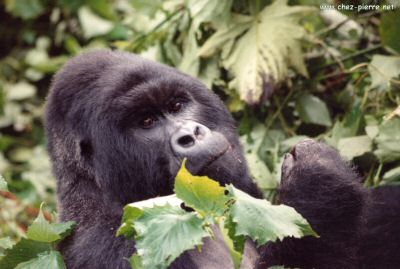
Rugabo, also called "Marcel" |
Gorilla gorilla beringeiIs its scientific
name. You have (re)discovered the moutain gorilla thanks
to the superb movie "Gorillas in the mist" with Sigourney Weaver playing
the role of Dian Fossey. This extraordinary woman lived
almost 18 years with the gorillas in this small tropical jungle area, on the Rwanda
side of the mountain bording Zaire and Uganda. Through her
work and the support she received, she created there the Karisoke Research Center. |

| It's also there she was murdered
on December 26 1985, hit 6 times with a machette on the head, maybe by poachers
against whom she was openly fighting. She has been buried in Karisoke, near the
gorillas cemetary. This famous primatologist left us exceptional
documents, killed the wrongful image of "King Kong" monsters and inspired
the protection efforts towards this animal who probably is our closest cousin. The
Dian Fossey Foundation continues her efforts for the protection of the gorillas,
you can even adopt one ! Sigourney Weaver is its Honorary President. Click
here to visit their site. |
Let's talk
about the gorillas
|
In 1989, about 600 mountain gorillas were counted in the area,
including about 325 on the Zaire side where I was. They were about half that number
in 1980, which proves that the protection programs were working well. There
are much more plain gorillas (about 50 000) and these are the only ones you can
see in the zoos. Mountain gorillas live in groups of 5 to
30 individuals, lead by a dominant male who is its absolute leader. He can reach
2 meters high and weigh more than 250 kg. The dominant male and the other males
older than 11 or 12 (their life expectancy is 20 to 40 years) are easily recognizable
by their "Silver back". Very powerful, the gorilla
is not agressive though, if he is respected. | 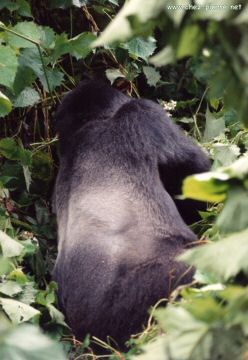
Even from the backside, he's dominant ! |
He's polygamous and his family can be huge ! Females can have 5 or 6 babies,
about one every 4 years. They are smaller than the males by about 30 centimeters,
and their social status depends on the order they joined the family. Yes,
I did say "social status", because gorillas do have a real social life
and real feelings, like Dian Fossey described : gorillas are not dumb !

"Come to play ?" | During
the day, the group wanders, the young gorillas play with some independance (they
are the only ones to climb the trees), and all enjoy eating quantities of plants,
mostly fruits and bamboo hearts (about 30 kg in all for an adult, every day !)
In the evening, each one makes a nest with branches and
leaves, even the young ones. They have to make a new nest every day since they
move a lot. |
Genocide : for the gorillas tooUnfortunately,
I can't avoid the subject, the exodus of the Rwandan refugees after 1994 was a
disaster for the gorillas too. Four Silverbacks, including
Rugabo (this page pictures) Salama and Luwawa were murdered. The
word is right, since their bodies were found with a bullet in the heart ! |

|
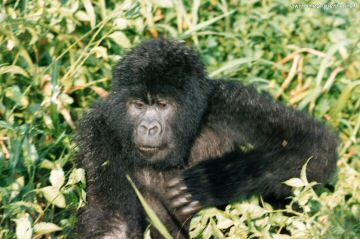
| Their bodies were untouched, but
the head of another dominant male (Mahehe ?) was found in 1995 at the market,
sold by a poacher for a few dozen dollars ! And it's not
just about them : scientific observations show that upon the dominant male death,
if another male cannot hold the group together and insure its safety, the group
splits and the gorillas join other families. Sometimes the young ones are killed
by the new dominant male to push the females to insure his own descent. |
How many of the gorillas presented here are still alive ?This
page could almost serve the purpose of a memorial.Let us also mention
that tourists going to visit the gorillas
were also murdered with machettes
(1999 ?) !
As for me, humble visitor...In
1991, we were absolutely not thinking all that would come. Only counted the souvenir
of Dian Fossey, who still had some friends in Goma, and the perpective of meeting,
face to face in the nature, the famous gorillas. We actually needed that motivation
to face the difficulties on the path to visit them ! I went to visit
the gorillas three times in 1991. When I went there for the second time, it was
with my mother and I didn't know if she would enjoy it : the first time, we had
to walk almost three hours in the tropical forest, in the mountains, opening a
path with the machettes, it was really exhausting. Let's talk about the
second trip :
we left the Rwindi (see the "Rwindi-3"
page), then...
The road
Until Rutshuru,
you know what I told you in the previous pages : bad track, but even a truck can
pass if the driver is careful. In Rutshuru, we must turn and take another track
towards the mountains. That's where everything gets complicated. But
first, let's be farseeing : in Djomba, there's a wood lodging, but no hotel nor
restaurant. So let's stop in the market : bananas, some vegetables, and two chicken.
Let's attach their legs (hey, they're alive of course) and put them in the back
of the Jeep. Back on the track : only 27 km to go, it shouldn't
be too long, and it's only the beginning of the afternoon. Naïve.We
got there in the evening, and we didn't haul, though ! This track is the worst
and most infamous I've ever seen, an alternance of mud lakes to go through, rocks
to climb, fords to wade... All this with two chicken who
desesperatly complain in our achy backs ! That day, we were
supposed to be about 20 people to go to Djomba, in seven vehicles. Only
three vehicles got there (the others broke down or gave up) : me and mom in my
Jeep Willys (even more adored since that day), an expatriate from Kinshasa and
his son in...a VW minibus (nobody ever understood how they passed, nor how/if
they went back), and three Swiss. These left Switzerland
to join the Cape with their Land Rover, and on this "little tiny bit of a
track" they broke the "joint de culasse" (?) and several shock
absorbers !
Djomba

| When at the bottom of the last hill, we
have to leave the Jeep and climb on foot. Fortunately, there's a bunch of M'totos
who will help carry the bags, the food and the cooler, since we cannot leave anything
in the Jeep but the Jerrycans which are well padlocked. What a climb ! On
this picture you can see my face right after. We settle in
the shared bedroom, give the chicken and the vegetables to a M'toto who will cook
our meal. The night is here already, and we musn't go to
bed too late : departure at 6 AM tomorrow with the guards to go look for the gorillas,
who could be really far away. But that's no reason not to
have fun either. |
Mom, me and the other hosts
of this lodge quickly found each other really nice, especially after having shared
our supplies since some were not really farseeing for the food...
On the menu (as far as I remember) :Chicken,
vegetables, bread and bananas
purchased in Rutshuru by Pierre and Anne-Marie
; Vegetables in conserves
brought by the Kin'
expatriate and his son ; Chocolate tablets
recovered
at the backpack's bottom
of one of the three Swiss ! Primus
Beer
brought by all. Wow, what an evening ! |
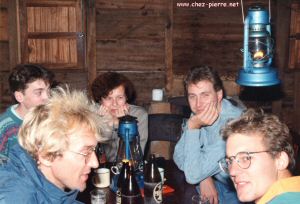
Two of the three Swiss,
The Kin' expatriate and his son,
and...Mom ;) |

| After a good night in the old beds, we're
up before dawn. There's some bread and chocolate left for breakfast, and we refresh
ourselves with rain water from the barrel outside. While anyway, our clothes hang
up by themselves... The sun rises and the scenery is wonderful... But
already we have to go, because we don't know how long we'll have to walk to find
a gorillas family yet : they can walk more than 10 kilometers every day. |
A long march with the machettes in the jungle ?
| Nope,
not this time. Rugabo's family is 100 meters behind the lodge ! Well, well, well...
The guard reminds us quickly of the basic rules : (1) A gorilla
bangs on his chest to show his worry and to impress. (2)
When a gorilla attacks, he does not punch his victim's chest. He does not bite
him either. He charges, and if the "victim" doesn't
move, he stops, right on time. I did experience it, and it's inexpressible. He
can stop a few centimeters from your nose ! | 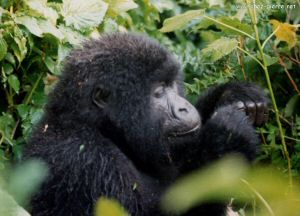
|
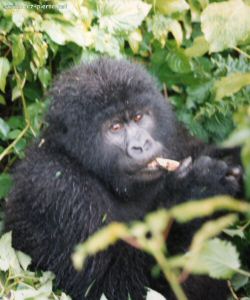
| If on the contrary the "victim"
flees or is agressive, the gorilla catches him by an arm or leg and runs, draging
him in the woods, which does have almost the same result. Rule
#3 : to avoid (1) and (2) we have to show submission. "Submission"
?Yep. In no time, we are in the middle
of the gorillas family. We have to sit down or lay on the ground, not looking
the gorillas in the eyes with insistance ; and if one of the males comes, we have
to bow our head. Simple as that ! |
| Well,
simple... Some tourists can't seem to be able to respect these rules. Of
course I have to say that when 250 kg gorilla comes to pat your shoulder or delouse
your hair, it can be difficult to stay perfectly relaxed. But
let's repeat it : the gorilla is not agressive and rarely uses his strength to
fight. He'll do it only to defend himself or his family. He'll not even use it
to defend a territory : when two families meet, most of the time they avoid direct
contact of pretend to ignore each others ! The guards are
armed, but to my knowledge they never had to use their rifles except against poachers. A
incident with a tourist would actually be very difficult to handle for them :
at the same time they have to protect the gorillas which are very rare,
and the tourists who finance this protection by paying for the visit ! |
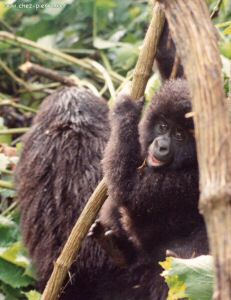
Mommy ! There's a whity who's
looking at me in the
eyes ! |

Ron... Zzz... | The
guards' mission does not stop there : - They have to
fight the poachers and other threats for the gorillas ; -
When there's no tourist, they still have to go visit the gorillas, not only to
know where they are, but also to keep them used to have visits. That's
how, while living freely in these totally wild forests, the Kivu gorillas do not
dislike receiving guests. |
| The tourist to whom I gave my camera missed
the picture, but I even had a young gorilla in my arms, delousing my hair, under
Rugabo's kind look ! Another time it was Rugabo himself,
passing in front of me, who stopped to grab and feel my shirt, probably thinking
"Funny fur on you !" Again, no picture of this
event : you would just have seen his black hair in a closeup ! Of
course we have to be very careful, especially with the babies and young gorillas
who are curious and often rash. They easily come to "play"
with you, but they are closely watched by the adults : so you have to let them
do without participating in their joy of pulling your hair, pinch you, search
your pockets... Not easy but fun ! | 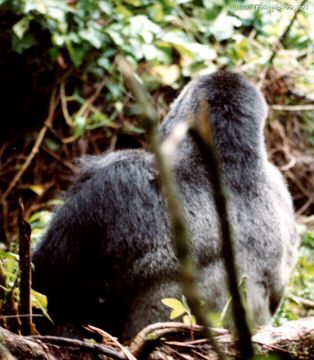
|
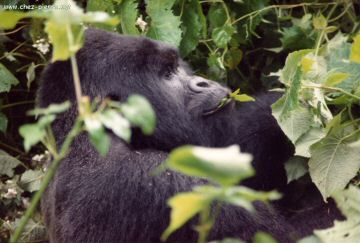
Rugabo, free, alive, happy in 1991. |
That said, they are not violent nor "brutal", they'll
not jump on you, and they are not thieves like the baboons. Actually,
it's at first quite surprising to see that these so powerful animals are so quiet.
They remind in that way numerous other big masters of the Reign : lions, elephants...
After all, when you have the power with you, no need to show
it off, right ? And better spare it for the real occasions. |
Finally, let's mention that "too close" contacts are not good
for the gorillas, since more than 150 human viruses and diseases, including a
simple flu, can make them really badly sick or even kill them. Add to this the
traps made by the peasants to catch other animals like the antilopes, the poachers,
the destruction of the forest...
The gorillas need help !
And
ya don't forget the guide, please !
These three visits
were the strongest experiences in my life.
These sites
are well worth a visit to learn more :
Can't miss that one : The
Dian Fossey Fundation Quite exhaustive, with serious documentation,
a little online shop to support their action
(you can even adopt a gorilla
!) with also a kids' section with games !
A French gorillas
protection association
ECOFAC Shows
that the genocide did not harm humans only.

Page créée le 16 juin 2001 - Mise à
jour le 23 juillet 2004
©opyright 1997-2007
Pierre Gieling - tous droits réservés

visitors
| |























